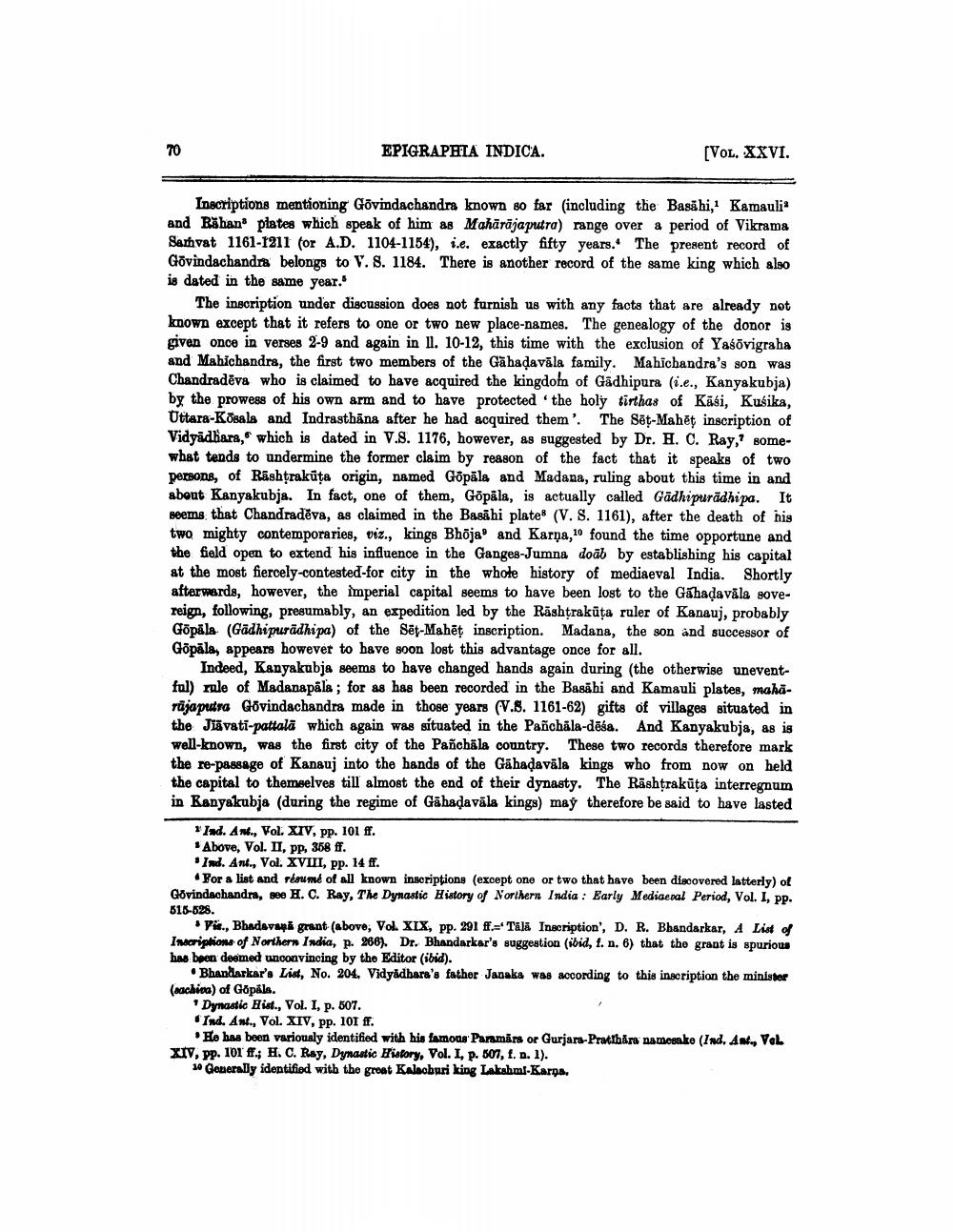________________
EPIGRAPHIA INDICA.
[VOL. XXVI.
Inscriptions mentioning Govindachandra known so far (including the Basāhi, Kamauli and Båhan plates which speak of him as Mahārājaputra) range over a period of Vikrama Sanhvat 1161-1211 for A.D. 1104-1154), i.e. exactly fifty years. The present record of Govindachandra belongs to V. 8. 1184. There is another record of the same king which also is dated in the same year.
The inscription under discussion does not furnish us with any facts that are already not known except that it refers to one or two new place-names. The genealogy of the donor is given once in verses 2-9 and again in II. 10-12, this time with the exclusion of Yašovigraha and Mabichandra, the first two members of the Gābadavāla family. Mahichandra's son was Chandradēva who is claimed to have acquired the kingdom of Gadhipura (i.e., Kanyakubja) by the prowess of his own arm and to have protected the holy tirthas of Käsi, Kusika, Uttara-Kosals and Indrasthāna after he had acquired them'. The Sēt-Mahēt inscription of Vidyadhara, which is dated in V.8. 1176, however, as suggested by Dr. H. C. Ray,' somewhat tends to undermine the former claim by reason of the fact that it speaks of two persons, of Rashtrakūta origin, named Gopāla and Madana, ruling about this time in and about Kanyakubja. In fact, one of them, Gopāla, is actually called Gadhipuradhipa. It seems that Chandradēva, as claimed in the Basāhi plates (V. S. 1161), after the death of his two mighty contemporaries, viz., kings Bhõja and Karna, 10 found the time opportune and the field open to extend his influence in the Ganges-Jumna doāb by establishing his capital at the most fiercely-contested-for city in the whole history of mediaeval India. Shortly afterwards, however, the imperial capital seems to have been lost to the Gahadavala govereign, following, presumably, an expedition led by the Rashtrakūţa ruler of Kanauj, probably Gopāla (Gadhipurädhipa) of the Sēt-Mahēt inscription. Madana, the son and successor of Göpäla, appears however to have soon lost this advantage once for all.
Indeed, Kanyakubja seems to have changed hands again during the otherwise uneventful) rule of Madanapäla; for as has been recorded in the Basāhi and Kamauli plates, maharūja pudra Govindachandra made in those years (V.8. 1161-62) gifts of villages situated in the Jiãvati-pattalā which again was situated in the Pañohäla-dēša. And Kanyakubja, as is well-known, was the first city of the Panchāla country. These two records therefore mark the re-passage of Kansuj into the hands of the Gahadavāla kings who from now on held the capital to themselves till almost the end of their dynasty. The Rashtrakūta interregnum in Kanyakubja (during the regime of Gāhadavāla kings) may therefore be said to have lasted
*Ind. Ant., Vol. XIV, pp. 101 ff. *Above, Vol. II, pp, 358 ff.
Ind. Ant., Vol. XVIII, pp. 14 ff.
For a list and résumé of all known inscriptions (except one or two that have been discovered latterly) of Govindachandra, se H. C. Ray, The Dynastic History of Northern India: Early Mediaeval Period, Vol. I, pp. 516-628.
Vit., Bhadavapk grant (above, Vol. XIX, pp. 291 ff. Tālā Inscription', D. R. Bhandarkar, A List of Inscriptions of Northern India, p. 266). Dr. Bhandarkar's suggestion (ibid, f. n. 6) that the grant is spurious has been deemed unconvincing by the Editor (ibid).
• Bhandarkar's List, No. 204. Vidyadhara's father Janaka was according to this inscription the minister (sachira) of Gopala.
Dynastic Hist., Vol. I, p. 507. Ind. Ant., Vol. XIV, pp. 101 ff.
He has been variously identified with his famous Paramāra or Gurjara-Pratthåra namesake (Ind. An., Val XIV, pp. 101' ff.: H. C. Ray, Dynastic History, Vol. I, p. 607, t. n. 1).
10 Generally identified with the great Kalacburi king Lakshmi-Karpa.




